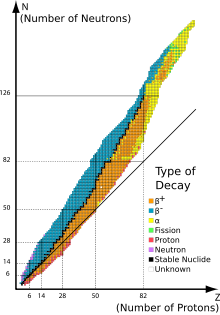
Beta-decay stable isobars are the set of nuclides which cannot undergo beta decay, that is, the transformation of a neutron to a proton or a proton to a neutron within the nucleus. A subset of these nuclides are also stable with regards to double beta decay or theoretically higher simultaneous beta decay, as they have the lowest energy of all isobars with the same mass number.
This set of nuclides is also known as the line of beta stability, a term already in common use in 1965.[1][2] This line lies along the bottom of the nuclear valley of stability.
- ^ Proc. Int. Symposium on Why and How should we investigate Nuclides Far Off the Stability Line", Lysekil, Sweden, August 1966, eds. W. Forsling, C.J. Herrlander and H. Ryde, Stockholm, Almqvist & Wiksell, 1967
- ^ Hansen, P. G. (1979). "Nuclei Far Away from the Line of Beta Stability: Studies by On-Line Mass Separation". Annual Review of Nuclear and Particle Science. 29: 69–119. Bibcode:1979ARNPS..29...69H. doi:10.1146/annurev.ns.29.120179.000441.
© MMXXIII Rich X Search. We shall prevail. All rights reserved. Rich X Search
